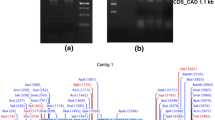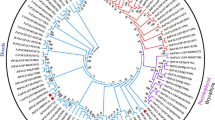Abstract
Phenylalanine ammonia lyase (PAL, EC 4.3.1.5) is the first committed limiting enzyme of phenylpropanoid pathway which catalyzes the deamination of phenylalanine to cinnamic acid. In the present study, we have cloned, functionally characterized and studied the expression pattern of phenylalanine ammonia lyase (PAL) involved in lignification of secondary cell wall. Phenylalanine ammonia lyase gene was cloned using RACE protocol from Erianthus arundinaceus (EaPAL). The 3.2-kb fragment consists of EaPAL with an ORF of 2116 bp encoding for 705 amino acid residues flanked by 172 bp of 5’ untranslated region and 300 bp of 3’ untranslated region. The tertiary structure of EaPAL showed 57% α-helixes, 3% β-sheet and 18% random coil regions with a calculated pI and molecular weight of 6.31 and ~ 77 KDa, respectively. The SDS-PAGE analysis showed that PAL protein was expressed at 1 mM IPTG induction at ~ 76 kDa. The expression profile of PAL across different tissues (leaf, stem and root) of a hybrid (Co 86032) and Erianthus (IK76-81) showed 2.5-fold increased expression in stem and root tissues of both the clones. Therefore, the genetic information, gene structure and expression of EaPAL might be used for achieving improved biofuel feedstocks.







Similar content being viewed by others
Availability of Data and Material
The complete gene sequence is within the article.
References
Bagal, Ujwal R., James H. Leebens-Mack, W. Walter Lorenz, and Jeffrey F.D. Dean. 2012. The phenylalanine ammonia lyase (PAL) gene family shows a gymnosperm-specific lineage. BMC Genomics 13 (Suppl 3): 1–9. https://doi.org/10.1186/1471-2164-13-s3-s1.
Chaman, Mercedes E., Sylvia V. Copaja, and Victor H. Argandoña. 2003. Relationships between salicylic acid content, phenylalanine ammonia-lyase (PAL) activity, and resistance of barley to aphid infestation. Journal of Agricultural and Food Chemistry 51: 2227–2231. https://doi.org/10.1021/jf020953b.
Cochrane, Fiona C., Laurence B. Davin, and Norman G. Lewis. 2004. The Arabidopsis phenylalanine ammonia lyase gene family: Kinetic characterization of the four PAL isoforms. Phytochemistry 65: 1557–1564. https://doi.org/10.1016/j.phytochem.2004.05.006.
Diallinas, George, and Angelos K. Kanellis. 1994. A phenylalanine ammonia-lyase gene from melon fruit: CDNA cloning, sequence and expression in response to development and wounding. Plant Molecular Biology 26: 473–479. https://doi.org/10.1007/BF00039557.
Ehrt, Sabine, and Dirk Schnappinger. 2003. Isolation of plasmids from E. coli by alkaline lysis. In Methods in molecular biology (Clifton, N.J.), ed. Nicola Casali and Andrew Preston. Totowa: Humana Press.
Hashemitabar, Mahmoud, Maryam Kolahi, Mohammad Reza Tabandeh, Parisa Jonoubi, and Ahmad Majd. 2014. cDNA cloning, phylogenic analysis and gene expression pattern of phenylalanine ammonia-lyase in sugarcane (Saccharum officinarum L.). Brazilian Archives of Biology and Technology 57: 456–465. https://doi.org/10.1590/S1516-8913201402061.
Hsieh, Lu Sheng, Guo Jhang Ma, Chien Chih Yang, and Ping Du Lee. 2010. Cloning, expression, site-directed mutagenesis and immunolocalization of phenylalanine ammonia-lyase in Bambusa oldhamii. Phytochemistry. https://doi.org/10.1016/j.phytochem.2010.09.019.
Jin, Qing, Yao Yao, Yongping Cai, and Yi. Lin. 2013. Molecular cloning and sequence analysis of a phenylalanine ammonia-lyase gene from Dendrobium. PLoS ONE e0062352. https://doi.org/10.1371/journal.pone.0062352.
Hans-Jurgen, J.O.O.S., and H.A.H.L.B.R.O.C.K. Klaus. 1992. Phenylalanine ammonia-lyase in potato (Solanum tuberosum L.). Genomic complexity, structural comparison of two selected genes and modes of expression. European Journal of Biochemistry 204 (2): 621–629. https://doi.org/10.1111/j.1432-1033.1992.tb16675.x.
Jun, Se Young, Steven A. Sattler, Gabriel S. Cortez, Wilfred Vermerris, Scott E. Sattler, and Chul Hee Kang. 2018. Biochemical and structural analysis of substrate specificity of a phenylalanine ammonia-lyase. Plant Physiology 176: 1452–1468. https://doi.org/10.1104/pp.17.01608.
Kasirajan, Lakshmi, Kalaivaani Aruchamy, Prathima P. Thirugnanasambandam, and Selvi Athiappan. 2017. Molecular cloning, characterization, and expression analysis of lignin genes from sugarcane genotypes varying in lignin content. Applied Biochemistry and Biotechnology 181: 1270–1282. https://doi.org/10.1007/s12010-016-2283-5.
Kasirajan, Lakshmi, Nam V. Hoang, Agnelo Furtado, Frederik C. Botha, and Robert J. Henry. 2018. Transcriptome analysis highlights key differentially expressed genes involved in cellulose and lignin biosynthesis of sugarcane genotypes varying in fiber content. Scientific Reports 8: 1–16. https://doi.org/10.1038/s41598-018-30033-4.
Kervinen, Timo, Sari Peltonen, Merja Utriainen, Jaakko Kangasjärvi, Teemu H. Teeri, and Reijo Karjalainen. 1997. Cloning and characterization of cDNA clones encoding phenylalanine ammonia-lyase in barley. Plant Science 123: 143–150. https://doi.org/10.1016/S0168-9452(96)04570-0.
Kolahi, Maryam, Parisa Jonoubi, Ahmad Majd, Mohamad Reza Tabandeh, and Mahmoud Hashemitabar. 2013. Differential expression of phenylalanine ammonia-lyase in different tissues of sugarcane (Saccharum officinarum L.) during development. BioResources 8: 4912–4922. https://doi.org/10.15376/biores.8.4.4912-4922.
Larkin, M.A., G. Blackshields, N.P. Brown, R. Chenna, P.A. Mcgettigan, H. McWilliam, F. Valentin, et al. 2007. Clustal W and Clustal X version 2.0. Bioinformatics 23: 2947–2948. https://doi.org/10.1093/bioinformatics/btm404.
Liu, Yufeng, Lijuan Liu, Shuai Yang, Qian Zeng, Zhiran He, and Yinggao Liu. 2019. Cloning, characterization and expression of the phenylalanine ammonia-lyase gene (PaPAL) from spruce Picea asperata. Forests. https://doi.org/10.3390/f10080613.
Livak, Kenneth J., and Thomas D. Schmittgen. 2001. Analysis of relative gene expression data using real-time quantitative PCR and the 2-ΔΔCT method. Methods 25: 402–408. https://doi.org/10.1006/meth.2001.1262.
Llerena, Juan Pablo, Raquel Figueiredo Portilla, Michael dos Santos, Eduardo Kiyota Brito, Juliana Lischka Sampaio. Mayer, Pedro Araujo, Flavia Camila Schimpl, Murali Dama, Markus Pauly, and Paulo Mazzafera. 2019. Deposition of lignin in four species of Saccharum. Scientific Reports 9: 1–19. https://doi.org/10.1038/s41598-019-42350-3.
Ma, Wen Li, Wu. Min, Wu. Yang, Zhu Mei Ren, and Yang Zhong. 2013. Cloning and characterisation of a phenylalanine ammonia-lyase gene from Rhus chinensis. Plant Cell Reports 32: 1179–1190. https://doi.org/10.1007/s00299-013-1413-6.
Mahesh, Venkataramaiah, Jean Jacques Rakotomalala, Lénaïg. Le Gal, Hélène. Vigne, Alexandre De Kochko, Serge Hamon, Michel Noirot, and Claudine Campa. 2006. Isolation and genetic mapping of a Coffea canephora phenylalanine ammonia-lyase gene (CcPAL1) and its involvement in the accumulation of caffeoyl quinic acids. Plant Cell Reports 25: 986–992. https://doi.org/10.1007/s00299-006-0152-3.
McCracken, Elizabeth, and Donald Alexander Johansen. 1940. Plant Microtechnique. Transactions of the American Microscopical Society. London: McGraw-Hill Book company Inc.
Sarma, Annamraju D., and Rameshwar Sharma. 1999. Purification and characterization of UV-B induced phenylalanine ammonia- lyase from rice seedlings. Phytochemistry 50: 729–737. https://doi.org/10.1016/S0031-9422(98)00608-6.
Shi, Rui, Christopher M. Shuford, Jack P. Wang, Ying Hsuan Sun, Zhichang Yang, Hsi Chuan Chen, Sermsawat Tunlaya-Anukit, et al. 2013. Regulation of phenylalanine ammonia-lyase (PAL) gene family in wood forming tissue of Populus trichocarpa. Planta 238: 487–497. https://doi.org/10.1007/s00425-013-1905-1.
Waclawovsky, Alessandro J., Paloma M. Sato, Carolina G. Lembke, Paul H. Moore, and Glaucia M. Souza. 2010. Sugarcane for bioenergy production: An assessment of yield and regulation of sucrose content. Plant Biotechnology Journal 8: 263–276. https://doi.org/10.1111/j.1467-7652.2009.00491.x.
Wanner, Leslie A., Guoqing Li, Doreen Ware, Imre E. Somssich, and Keith R. Davis. 1995. The phenylalanine ammonia-lyase gene family in Arabidopsis thaliana. Plant Molecular Biology 27: 327–338. https://doi.org/10.1007/BF00020187.
Wen, Peng Fei, Jian Ye Chen, Wei Fu Kong, Qiu Hong Pan, Si Bao Wan, and Wei Dong Huang. 2005. Salicylic acid induced the expression of phenylalanine ammonia-lyase gene in grape berry. Plant Science 169: 928–934. https://doi.org/10.1016/j.plantsci.2005.06.011.
Acknowledgements
The authors wish to thank Dr. G. Hemaprabha, Head, Division of Crop Improvement, ICAR Sugarcane Breeding Institute, Coimbatore, for kindly providing sugarcane clones.
Funding
This work was financially supported by Indian Council of research (ICAR SBI P1-15/1–4: (V)).
Author information
Authors and Affiliations
Contributions
Authors Lakshmi Kasirajan contributed to the study conception and design. Material preparation, data collection and analysis were performed by Lakshmi Kasirajan, Rabisha Valiyaparambth and Keerthana Kamaraj. Gadha Ajith, Jijo Joise, Aathisivan Kubandiran and Janani Velu performed sequence analysis. The first draft of the manuscript was written by LK, RV, KK and KK, and LK critically revised the manuscript. All authors read and approved the final manuscript.
Corresponding author
Ethics declarations
Conflict of interest
The authors declare no conflict of interest.
Additional information
Publisher's Note
Springer Nature remains neutral with regard to jurisdictional claims in published maps and institutional affiliations.
Supplementary Information
Below is the link to the electronic supplementary material.
Rights and permissions
About this article
Cite this article
Kasirajan, L., Valiyaparambth, R., Kamaraj, K. et al. Full-Length Cloning, Expression and Functional Characterization of Phenylalanine Ammonia Lyase (PAL) Involved in Lignification of Secondary Cell Wall of Erianthus arundinaceus. Sugar Tech 24, 1728–1737 (2022). https://doi.org/10.1007/s12355-022-01147-x
Received:
Accepted:
Published:
Issue Date:
DOI: https://doi.org/10.1007/s12355-022-01147-x




